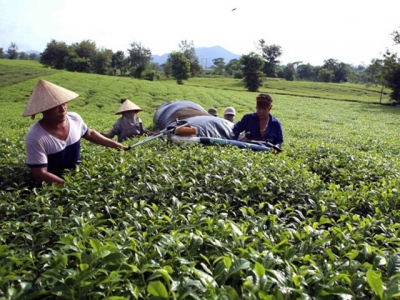Phu Tho pushes high-tech application in agricultural production

Harvesting tea leaves in Dich Qua commune, Thanh Son district, Phu Tho (Photo: VNA)
Phu Tho (VNA) – The northern midland province of Phu Tho’s efforts to apply advanced technologies in agriculture have paid off, creating production areas with high quality and productivity.
Based on its advantages in terms of convenient transport infrastructure and a favorable ecosystem, the province has worked to boost investments in agriculture. Within the past five years, it attracted 42 enterprises investing in animal husbandry, crop cultivation, fisheries, and animal feed processing.
The mergence of land plots, which is being performed across 94 communes, has been utilised to lay the basis for the formation of large-scale high-tech farming zones. To date, concentrated plantations of rice, corn, and various fruits have been established in Phu Tho town, as well as the districts of Lam Thao, Tam Nong, Thanh Son, Thanh Ba, Ha Hoa, Thanh Thuy, and Doan Hung.
In Tam Nong alone, 19 out of 20 communes with 13,000 households have taken part in the land merging process, with its high-tech agricultural area now spanning over 10ha. Local farmers have also enjoyed assistance from the provincial authorities to develop their farming practices.
In 2015, Nguyen Hoang Manh, a resident in Huong Non commune, invested over 400 million VND (17,117 USD) borrowed from the bank in building a 1,500sq.m net house to grow vegetables. After a while, his model proved effective and he was aided by the provincial authorities to construct a polytunnel on nearly 3,500sq.m of land. The entire project cost 2.7 billion VND (115,572 USD), close to 30 percent of which was covered by Manh’s family. Inside the polytunnel, his family mainly grows muskmelon, cucumber, tomato, and other seasonal vegetables and fruit.
Manh’s farming model applies a system of nets, convection fans, drip irrigation, and sprinkler irrigation. The cultivation process strictly follows set standards, thus reducing the use of pesticides and producing healthy plants. Net house farming also has the major advantage of not being weather-dependent, so farmers can take control of the production plan and minimise the risk of failed harvests. As such, each year, the model allows the cultivation of at least three crops, with the output reaching about 1.5-4 tonnes of vegetables and fruits per 360sq.m and profits ranging from 400-500 million VND (17,120-21,400 USD).
Manh said his family used to follow the traditional practice of small and scattered production, which resulted in low yield and quality. According to him, after receiving assistance from the province to build a greenhouse system and apply advanced technology in production, material and labour costs were reduced and productivity was 1.5 times higher.
Currently, many agricultural production models are being deployed across Phu Tho in accordance with the specific conditions of each region, connecting farmers to businesses through agricultural product distribution contracts.
From the linkage, farmers have received investment and technical support, and secured a stable output and better incomes. Meanwhile enterprises can ensure a constant supply of material sources, expand production scale, and increase competitiveness.
Economic efficiency has been recorded for a number of local units following the model, including the production of exported bananas in Tam Nong, safe vegetables in Lam Thao and Cam Khe, and the distribution of chicken meat in Viet Tri city.
However, amid global integration, farm produce nationwide, including those in Phu Tho, will face competition from foreign products. Effective agricultural restructuring has become a crucial step for the large-scale production of high-quality and competitive goods.
According to Tran Tu Anh, Deputy Director of the provincial Department of Agriculture and Rural Development, the work requires a gradual change in the production mindset of local farmers, which in turn needs concerted efforts, guidance, and communications activities from authorities and related organisations.
In the coming time, the local agriculture sector will push for production restructuring in the planning of agriculture, forestry, and fishery development; as well as the issuance of favorable policies targeting farmers and investors. It will also deliver frequent market updates to guide production; develop concentrated farming areas; and strengthen the link among the production, processing, and distribution channels of farm produce.
Related news
 Coffee exports rise, but value stagnates
Coffee exports rise, but value stagnates Việt Nam exported 1.46 million tonnes of coffee worth US $2.77 billion in the first three quarters of 2018, an increase of 20.1 per cent in volume
 Farmers earn high profits from organic cocoa cultivation techniques
Farmers earn high profits from organic cocoa cultivation techniques The use of advanced farming techniques has resulted in high profits for organic cocoa farmers in the southern province of Bà Rịa - Vũng Tàu.
 Đà Nẵng eyes hi-tech farms
Đà Nẵng eyes hi-tech farms Đà Nẵng plans to prioritise a hi-tech agricultural zone in Hòa Vang District to attract more investment in modern farming.